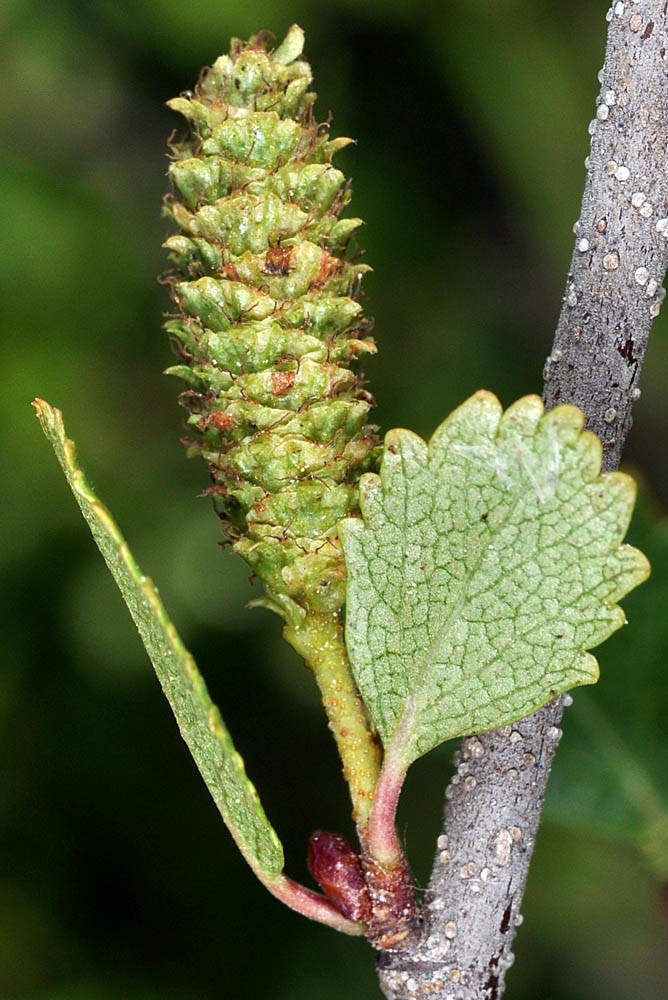Betula pumila
Betula glandulosa
bog birch
resin birch
ascending, finely puberulent with hairs to 0.1 mm and spreading hairs ~0.3–0.4 mm; when young dry or glutinous, with scattered resin-blisters.
ascending, glabrous or puberulent with spreading hairs to 0.1 mm; dry or rarely glutinous near apex, with few to many resin-blisters.
blades obovate, elliptic, or almost circular, 22–40 × 15–31 mm, green above, light green beneath; firm but flexible, bases obtuse or rounded;
margins crenate from base to tip with 14–19 strong rounded crenations on each margin, usually all approximately same size, 1–2 mm;
secondary veins obscure, 4–6 on each side;
tips broadly obtuse or rounded;
surfaces glabrous;
petioles 4–7 mm, glabrous or puberulent.
blades elliptic to almost circular, 15–28 × 12–21 mm (on fertile branches; up to 37 × 31 mm on sterile branches), green above, light green beneath; firm but flexible, bases obtuse or rounded (seldom broadly acute);
margins crenate; crenations obtuse or rounded, 8–15 on a side, usually all approximately same size; ~1 mm;
secondary veins 3–4(5) on each side;
tips broadly rounded;
surfaces abaxially glabrous or both sides vernicose;
petioles 3–7 mm, glabrous.
very narrowly winged.
narrowly winged.
15–23 mm;
bracts with lateral lobes often shorter and broader than middle lobe.
15–24 mm;
bracts with a long; narrow central lobe and short; broad lateral lobes.
Betula pumila
Betula glandulosa
Boggy margins of lakes. Flowering May–Jun. 0–1300 m. Casc, ECas, WV. CA, ID, WA; north to Yukon, east to Newfoundland. Native.
Many specimens of B. pumila from eastern North America have longer, denser pubescence on the twigs and few or no glandular blisters. Our western plants, with sparser pubescence and more numerous glands, are sometimes separated as a distinct taxon (B. hallii or B. pumila var. glandulifera; Dugle 1966; Hitchcock & Cronquist 1964), but the two forms intergrade. Furlow (1997) argues against recognizing segregate taxa.
Wet meadows, bottomlands, swamps, streambanks. Flowering May–Jul. 300–2200 m. BR, BW, Casc, ECas, Lava. CA, ID, WA; north to AK, east to Greenland. Native.
Betula glandulosa and B. pumila are morphologically similar and difficult to distinguish. Elsewhere in North America, B. glandulosa is diploid and B. pumila is tetraploid, but no chromosome counts have been made from the Pacific Slope populations. Dugle (1966) has reported B. glandulosa × B. pumila (B. × sargentii) and B. glandulosa × B. occidentalis (B. × eastwoodiae) from other parts of western North America, but neither hybrid has been confirmed from Oregon.
Alan Whittemore
Alan Whittemore
- Local floras:
BC,
OR,
WA
- Local Web sites:
Flora NW,
PNW Herbaria
WildflowerSearch
iNaturalist (observations)
USDA Plants Database
- LBJ Wildflower Center
- SEINet
- Plants of the World Online
- Encyclopedia of Life
- Wikipedia
- Google Image Search
- Local floras:
BC,
CA,
OR,
WA
- Local Web sites:
CalFlora,
CalPhotos,
Flora NW,
PNW Herbaria
WildflowerSearch
iNaturalist (observations)
USDA Plants Database
- LBJ Wildflower Center
- SEINet
- Plants of the World Online
- Encyclopedia of Life
- Wikipedia
- Google Image Search





